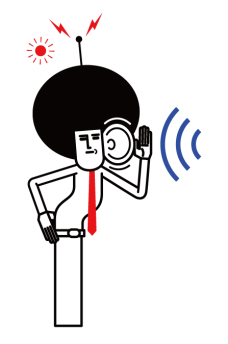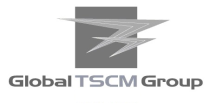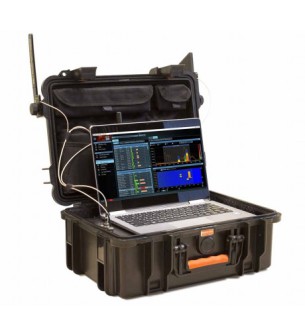The Stealth Delta 2000/6GHz Countersurveillance sweeping system
Features
- High update rate, 2000-3000 MHz per second
- Frequency range 40 kHz – 6000 MHz
- Reaction time: 2-3 seconds
- Instantly detects digital signals with short bursts
- Can detect and locate the transmitter simultaneously
- Quickly and reliably detects all kinds of RF listening devices, including analog, digital, constantly existing and intermittent, sending audio or video, with or without encryption
- Finds hidden surveillance devices employing the digital standards GSM, 3G, 4G/LTE, Bluetooth, Wi-Fi, DECT, etc.
- Detects illegal information transmission in AC, telephone, Ethernet, alarm and other wires as well as in the infrared range with the help of the supplied Multifunction Probe
- Can work in instant detection mode, guarding mode, locating mode and car tracker detection
- Has a 20-50 times higher sensitivity and detection distance compared to conventional RF detectors and near-field receivers
- Can monitor the RF environment 24 hours a day with data logging
- Capable of detecting covert bugging devices with an accumulation function and transmitters hidden within the spectrums of other signals
- Supports storage of an unlimited quantity of signals. Full information is stored in the log and can be reviewed during the detection, or at a later time. Multiple logs are supported.
- Demodulation of audio in FM, AM, USB, LSB, CW (adjustable BW 3…240 kHz)
- Alarm relay output can activate external devices when a dangerous signal is detected (turn on a CCTV system, for example)
- Comes in a protected case that allows you to place a 13-14” laptop inside (not included in the supplied set)
- Powered from the laptop’s USB
Advantages
| ✦ | What it is: a portable system controlled by a laptop computer | |
|
||
| ✦ | Handling of the mobile and wireless bands GSM, CDMA, 3G, 4G/LTE, DECT, Wi-Fi, Bluetooth, etc. | |
|
||
| ✦ | Sensitivity and detection distance | |
|
||
| ✦ | Support of the "Known signals" table | |
|
||
| ✦ | Advanced signal recognition method | |
|
||
| ✦ | Unique algorithm of measuring the signal's Danger level | |
|
||
| ✦ | Low demands on the operator's level of knowledge | |
|
||
| ✦ | Data logging | |
|
||
| ✦ | Tracking of the signal's activity | |
|
||
| ✦ | The Waterfall and Persistence graphs | |
|
||
| ✦ | Car Tracker Detector mode | |
|
||
Specification
- Update rate: 2000-3000 MHz/sec
- Frequency range: 40 kHz - 6000 MHz
- Time of detection (Minimal time of signal’s existence needed for its detection): 2-3 sec
- Spectrum resolution: 9 kHz
- Occupied disk space per 24 hours: 12 Gb
- Temperature Range: 0°C to +65°C
- Demands on computer: 3rd gen. or newer Intel dual/quad Core i-series; 1 x USB 3.0; 2 x USB 2.0; Windows 7, 8 , 10
- Displayed dynamic range: -90…-10 dBm
- Displayed spectrum spans: 0.5, 1, 2, 5, 10, 25, 50, 100, 200, 500, 1000, 2000, 3000, 6000 MHz
- Spectrum graphs: Spectrogram, Waterfall
- Spectrogram’s displayed data: Persistence, Live, Max, Threshold
- Detector’s modes: Wide-Range, Signal, Selection
- Fields of ‘Signals’ table: Frequency, Bandwidth, Name, dbm Level, dbm Peak Level, Danger Level, Peak Danger Level
- Fields of ‘Bands’ table:Begin, End, Name, Type, Threshold, Priority, Tracker detection
- Fields of ‘Known Signals’ table: Frequency, BW, Name, Modulation
Functions of the software
- Rich visual representation: Spectrogram/Persistence, Waterfall, Alarms graph
- The Known Signals table allows the system to reject TV, FM and other "friendly" signals while maintaining high sensitivity to unknown signals.
- The Detector and Locator allow the operator to perform location of a bugging device with both visual and audio notification
- The Alarm Threshold decreases the false alarm rate
- The Hold Max Danger feature selects and shows the strongest signals for their location as the system is moved during detection
- The Update Mask procedure allows the operator to quickly adjust the system to the local RF environment in order to reject safe signals
- Sorting and filtering is supported in the Signals table
- The Report function allows the operator to export all obtained information about the desired signals
- Is easily localizable to any language
Working modes
- Stop/View Log
Review of the detection results stored in the log. The Signals table, Spectrogram, Waterfall and Alarms graph give full information about the detected signals and alarm events - Update masks
Quick preparation for detection – the system automatically accumulates the broadcasting and other safe signals existing in the area in order to pass over them during the subsequent detection - RF Sweep
The main detection mode. Provides maximum reaction time and the highest sensitivity. The operator can move the system or its antenna during the detection. - Guard 24/7
Rejection of short transmissions and usage of two antennas reduces false alarms in this mode. Suitable for 24 hour detection without unwanted false alarms - Car Tracker Detector
Detection of vehicle mounted GPS trackers transmitting the coordinates via mobile networks - Probe
Checking of AC, Ethernet, Telephone and Alarm wires and the infrared/low frequency for the presence of unwanted bugging signals - Signal Analyzer
Analysis, demodulation and physical locating of detected signals - Settings
Includes the general settings and information about the mobile networks and wireless bands existing in the area as well as the known signals table
Supplied set
- Main unit with the built-in spectrum analyzer and RF switcher
- Software Delta X on the USB flash memory
- ODA-4 - omnidirectional antenna
- MWA-6 - microwave antenna
- Multifunction Probe with cables
- Coaxial low-attenuation cable 5 m
- In-line modular adapter
- Tripod convertible to handle
- Set of accessories (case's cover lock, angle USB adapters, BNC-to-SMA and SMA-to-BNC adapters)






